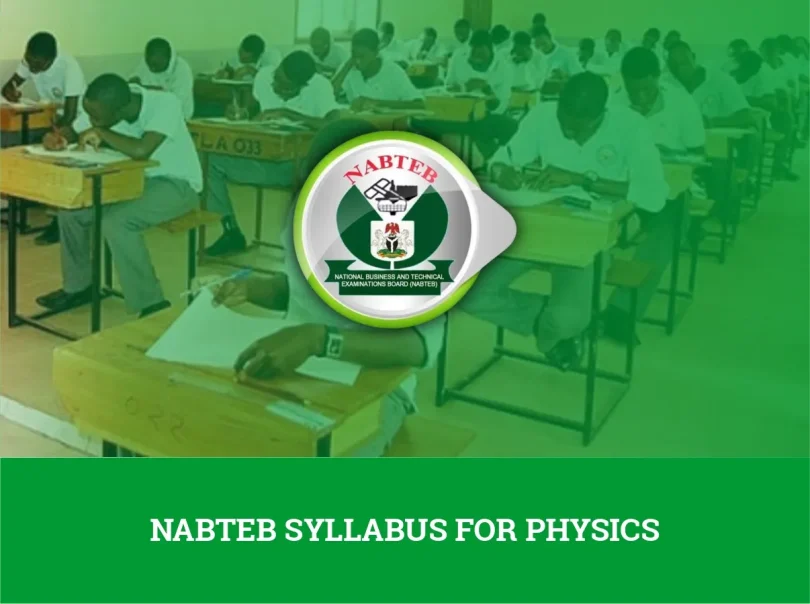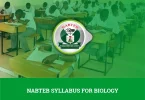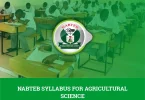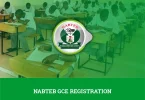Physics can seem tough, and all those formulas, laws, and calculations might make your head spin. But many students don’t realize that physics is everywhere, and it is one of the most powerful tools you can have in your academic journey and future career. Physics is about understanding how the world works, motion, energy, light, heat, electricity, and even the mysteries of the universe.
The NABTEB Physics syllabus is provided as your map to master this course and prepare for your exams. It tells you everything you need to know, topic by topic, so you can prepare smartly and not blindly.
In this article, we will show you the NABTEB Syllabus for Physics, breaking down what you need to study, focus on, how to connect it to real life, and how the exam questions will be. Students aiming to ace the NABTEB physics exam should ensure they study, understand, and use this guide!
NABTEB Syllabus for Physics 2025
The NABTEB Syllabus for Physics is based on the NABTEB curriculum and is created mainly to guide students preparing for the exam. It shows Physics as an important science subject, focusing on helping students understand key concepts like matter, motion, energy, waves, forces, atoms, nuclear physics, and electronics. The goal is to build both knowledge and practical skills in these areas.
AIMS OF THE SYLLABUS
The syllabus aims to help students:
- Truly understand the basic ideas and real-life uses of Physics.
- Gain the scientific knowledge and skills they need for further studies or careers.
- Learn to think scientifically to get rid of ignorance and superstition.
- Develop the right scientific attitudes, like being accurate, creative, and objective, which are important for technological progress.
SCHEME OF EXAMINATION
Physics in NABTEB is tested in two papers (Paper 1 and Paper 2), and together, they make 200 marks.
PAPER 1: Theory Paper – 130 Marks
It has two parts:
- Section A: Objective Questions
- 50 multiple-choice questions.
- Covers the entire syllabus.
- Duration: 1 hour 15 minutes
- Marks: 50
- Section B: Essay Questions
- 5 questions will be set; you will answer any 4.
- Duration: 1 hour 30 minutes
- Marks: 80
PAPER 2: Practical or Test-of-Practical – 70 Marks
- You will be given 3 practical questions and asked to do any 2.
- Duration: 2 hours 45 minutes
- Marks: 70
Note: If you are a private candidate writing the exam in Nov/Dec, you will write a “test-of-practical” (a theory version of the practical) instead of doing real lab experiments.
Key Topics in the NABTEB Physics Syllabus
PART 1 – MECHANICS
Here is what you need to study:
1. Concept of Matter
- Understand solids, liquids, and gases.
- Learn how particles behave using Kinetic Theory.
- Study evaporation, boiling, and types of substances (crystalline and amorphous).
2. Fundamental Quantities and Units
- Learn basic physical quantities like length, mass, and time, and their units.
- Understand how to measure them using tools like rulers, vernier calipers, etc.
- Know derived quantities like area, volume, speed, etc.
3. Position, Distance & Displacement
- Know the difference between distance (how far) and displacement (change in position).
- Learn how to represent a position on a graph or in a coordinate system.
4. Speed, Velocity & Acceleration
- Learn the meaning of speed (how fast), velocity (speed with direction), and acceleration (change in velocity).
- Master equations for motion and use graphs to analyze movement.
5. Motion of Bodies
- Understand types of motion: linear, circular, oscillatory, etc.
- Learn about forces (push/pull) and how they cause motion.
- Study friction, how to reduce it, and its effects.
- Understand Newton’s Laws of Motion and how they apply in real life (like rockets and vehicles).
6. Scalar and Vector Quantities
- Learn the difference: Scalars have only size (e.g., mass), Vectors have size and direction (e.g., velocity).
- Practice adding vectors using the parallelogram or triangle methods.
7. Projectile Motion
- Study how objects move when thrown (e.g., a ball in the air).
- Learn to calculate range, height, and time of flight.
8. Mass and Weight
- Know that mass is the amount of matter in an object, and weight is the force of gravity on it.
- Use the formula: Weight=Mass×g\text{Weight} = \text{Mass} \times gWeight=Mass×g
9. Density and Relative Density
- Learn how to find the density of objects and compare their densities (relative density).
- Practice simple measurements and calculations.
10. Fluid at Rest
- Understand pressure in liquids and gases.
- Study devices like barometers, pumps, and siphons.
- Learn Pascal’s and Archimedes’ principles and how to apply them.
11. Surface Tension
- Know what makes water form droplets and how liquids behave on surfaces.
- Study adhesion, cohesion, and capillarity.
12. Elastic Properties of Solids
- Learn how solids stretch and return to shape (like springs).
- Understand Hooke’s Law, stress, strain, and Young’s modulus.
13. Equilibrium of Forces
- Study how forces balance in still or stable objects.
- Understand moments (turning effects) and how to find the center of gravity.
- Know how to keep things stable (like buildings or bridges).
14. Simple Harmonic Motion (SHM)
- Learn about repetitive motion (e.g., pendulum, spring).
- Study period, frequency, speed, energy, and resonance.
15. Energy
- Understand different types of energy (mechanical, heat, chemical, etc.).
- Learn about energy conservation and renewable vs. non-renewable sources.
16. Work, Energy & Power
- Learn what work is in Physics (force × distance).
- Understand kinetic and potential energy, and how to calculate power.
17. Simple Machines
- Study tools that make work easier (e.g., levers, pulleys).
- Learn about mechanical advantage, velocity ratio, and efficiency.
- Understand how friction affects machines.
PART II – Heat Energy
Heat Energy in Physics deals with how heat behaves, how it’s measured, and its effects on matter. This is a key part of your theory and practical exams.
18. Concept of Temperature
- Learn what temperature means and how it’s different from heat.
- Study the types of thermometers (e.g., clinical, minimum, and maximum).
- Know how thermometers work, the materials used, and how to convert between Celsius, Kelvin, and Fahrenheit.
- Understand how to read, construct, and use a simple thermometer.
19. Effects of Heat
19.1 What Heat Does – Heat can cause:
- Increase in temperature
- Change of state (like ice melting)
- Expansion of materials
- Change in electrical resistance
- Real-world examples: railway tracks expand, bridges expand, and thermostats use heat to function.
19.2 Thermal Expansion
- Learn how solids and liquids expand when heated.
- Know these key terms:
- Linear expansivity (α) – how length changes
- Area expansivity (β) – how surface area changes
- Volume expansivity (γ) – how volume changes
- Understand the formulae and solve calculation problems.
19.3 Anomalous Expansion of Water
- Water behaves strangely between 0°C and 4°C — it expands when cooled, not heated.
- This property helps aquatic life survive in cold weather.
20. Heat Transfer
20.1 Modes of Heat Transfer
- Heat moves in three ways:
- Conduction (through solids)
- Convection (through fluids)
- Radiation (without a medium, e.g.the , sun)
- Learn examples of each and how kinetic theory explains them.
20.2 Thermal Conductivity
- Compare how well different materials (like metals or liquids) conduct heat.
- Understand good and bad conductors — e.g., copper vs. wood.
20.3 Radiation and Absorption
- Study how different surfaces (black, white, shiny) absorb or give off heat.
- Know the applications of heat transfer (like the design of vacuum flasks, cooking pots, and roofing materials).
21. Gas Laws
- Know these three gas laws:
- Boyle’s Law – Pressure & volume
- Charles’ Law – Volume & temperature
- Pressure Law – Pressure & temperature
- Understand them using kinetic theory and be able to solve gas law problems.
- Learn how to verify Boyle’s and Charles’ laws through experiments.
22. Heat Capacity
22.1 Heat Capacity & Specific Heat Capacity
- Heat capacity = how much heat a material can absorb.
- Specific heat capacity = heat needed to raise 1 kg of a substance by 1°C.
- Learn how to:
- Calculate the quantity of heat (Q = mcΔT)
- Measure specific heat capacity using the mixture or electrical method.
- Understand how water’s high heat capacity affects land and sea temperatures.
23. Latent Heat
23.1 Understanding Latent Heat
- Latent heat is the heat used to change the state of matter (solid, ⇌ liquid ⇌ , gas) without changing temperature.
- Know:
- Fusion = solid to liquid
- Vaporization = liquid to gas
- Calculate specific latent heat (e.g., for ice or steam).
- Study real-world applications like pressure cookers and refrigerators.
Bonus Concepts:
- Boiling vs. Evaporation (evaporation is slower and happens at any temperature)
- Vapour pressure, humidity, and dew point
- How mist, fog, rain, and dew are formed
- How to measure humidity using a wet and dry bulb hygrometer
PART III – WAVES, OPTICS, and SOUND
24. Waves -What Are They?
What to Know:
- Waves are vibrations that carry energy.
- Two types:
- Transverse waves – particles move up and down (e.g., light).
- Longitudinal waves – particles move back and forth (e.g., sound).
- Learn wave terms:
- Amplitude – height of wave.
- Wavelength (λ) – distance between two peaks.
- Frequency (f) – how often waves pass per second.
- Period (T) – time for one wave cycle.
(f = 1/T)- Wave speed (V) = f × λ
- Learn wave behaviors: reflection, refraction, diffraction, and interference.
- Use ripple tanks to see waves in action.
25. Light Waves (Optics)
Light Basics:
- Light comes from luminous objects (e.g., the sun, bulbs).
- Rectilinear propagation = light travels in straight lines.
- Applications: Shadows, eclipses, and pin-hole cameras.
Reflection of Light:
- Bounces off surfaces like mirrors.
- Follow the laws of reflection: Angle of incidence = angle of reflection.
- Uses: Periscope, sextant, mirrors in cars/dentistry.
Refraction of Light:
- Light bends when it enters a new medium (e.g., from air to water).
- Snell’s Law and refractive index explain how it bends.
- Applications: lenses, optical fibers, rainbows, prisms, and mirages.
Lenses:
- Convex lenses – focus light, used in magnifiers, microscopes.
- Concave lenses – spread light, used in eyeglasses for short-sightedness.
- Learn to draw ray diagrams and solve problems using:
- 1/f = 1/v – 1/u
- Magnification (m) = v/u
Dispersion & Colour:
- Dispersion = white light splits into colors (rainbow).
- Primary colors: red, green, blue.
- Mixing pigments = art/printing.
- Learn real-life examples (e.g., prisms, rainbows, TVs).
Optical Instruments:
- Learn how cameras, eyes, microscopes, and telescopes work.
- Understand common eye defects and how lenses correct them.
26. Electromagnetic Waves
- Unlike sound, these waves don’t need a medium.
- Includes: Radio, microwaves, infrared, visible light, UV, X-rays, gamma rays
- Learn their uses and dangers.
27. Sound Waves
What to Know:
- Sound needs a medium (solid, liquid, gas).
- The speed of sound changes with medium, temperature, and pressure.
- Concepts to learn:
- Echo and how it’s used to measure depth (e.g., sonar).
- Pitch, loudness, quality (musical note vs noise).
- Forced vibration & resonance (e.g., guitar body amplifying string sound).
- Open & closed pipes (e.g., flute vs clarinet).
- Solve problems using:
- v = fλ
- f₀ = v/4L (for closed pipe), f₀ = v/2L (for open pipe)
PART IV – FIELDS and ELECTRICITY
28. Fields (Gravitational, Electric, Magnetic)
Key Concepts:
- Field = a region where a force can be felt (even if the object is not touching).
- Types:
- Gravitational attraction between masses.
- Electric force between charges.
- Magnetic force from magnets or current.
29. Gravitational Field
- Understand:
- Newton’s Law of Gravitation
- Gravity varies by location, height, and the Earth’s rotation
- Escape velocity – the speed needed to leave Earth
- Calculations: gravitational potential, field strength, etc.
30. Electric Fields & Current Electricity
Static Electricity
- Charges created by rubbing, contact, or induction.
- Use of gold-leaf electroscope, electric lines of force.
- Coulomb’s Law:
F = k(q₁q₂)/r²
(force between charges)
Capacitance & Capacitors
- A capacitor stores electric charge.
- C = εA/d
- Uses: radios, flash cameras, filters.
- Learn:
- Energy stored: E = ½ CV², ½QV, or ½Q²/C
- Series and parallel combinations
31. Current Electricity
Understand:
- Simple and secondary cells
- Ohm’s Law: V = IR
- Internal resistance of cells
- Series/parallel circuits
- Energy: E = VIt
- Power: P = VI or P = I²R
- Electrical heating in kettles, irons
32. Electrical Measurement Tools
Tools:
- Voltmeter – measures voltage
- Ammeter – measures current
- Potentiometer, Metre bridge – used in practicals
Resistivity:
- R = ρL/A
(where ρ = resistivity) - Factors: material, length, thickness, temperature.
Electrolysis & Conduction in Liquids
- Electrolysis = using electricity to cause chemical change.
- Anions (−), Cations (+)
- Learn:
- Faraday’s Laws
- Uses: electroplating, purification of metals
33. Magnetism
Learn:
- Magnetic materials
- Earth’s magnetic field
- Electromagnets (used in bells, motors)
- Fleming’s left-hand rule (force on wire)
- Right-hand grip rule (field around wire)
34. Electromagnetic Induction
- Faraday’s Law: moving magnets = electric current
- Lenz’s Law: direction opposes change
Devices:
- Transformers (step-up, step-down)
- Generators (AC, DC)
Learn:
- E = E₀sinωt
- How inductors work
- Eddy currents and how to reduce them
35. Simple A.C. Circuit
Understand:
- AC wave graphs
- Peak vs RMS values
(E₀ = √2 × Erms)
Learn:
- Impedance (Z), reactance (XL, XC)
- Resonance: when XL = XC
- Application: radios, TVs
PART V Atomic Models and Their Limitations
Thomson Model (Plum Pudding Model)
- Description: Proposed by J.J. Thomson in 1904, this model depicted the atom as a positively charged “pudding” with negatively charged electrons embedded like “plums”.
- Limitation: It couldn’t explain the scattering results from Rutherford’s gold foil experiment, which showed that atoms have a small, dense nucleus.
Rutherford Model
- Description: In 1911, Ernest Rutherford discovered that atoms have a tiny, dense nucleus surrounded by electrons.
- Limitation: It couldn’t explain why electrons don’t spiral into the nucleus due to electromagnetic radiation.
Bohr Model
- Description: Niels Bohr, in 1913, proposed that electrons orbit the nucleus in fixed paths or “shells” without radiating energy.
- Limitation: It only worked for hydrogen-like atoms and couldn’t explain the spectra of more complex atoms.
Electron Cloud Model
- Description: Developed in the 1920s, this model suggests that electrons don’t have fixed positions but exist in regions of probability around the nucleus.
- Limitation: While more accurate, it doesn’t provide a clear visual representation of electron paths.
36. Key Concepts in Atomic Physics
- Quantization of Angular Momentum (Bohr): Bohr proposed that the angular momentum of an electron is quantized, meaning it can only take certain discrete values.
- Energy Quantization: Energy levels in atoms are quantized, meaning electrons can only occupy specific energy levels and not values in between.
- Absorption and Emission Spectra: When electrons absorb energy, they jump to higher energy levels. When they fall back, they emit light of specific wavelengths, creating line spectra.
- Photoelectric Effect: When light shines on a metal surface, it can eject electrons from the metal. The energy of the ejected electrons depends on the frequency of the light, not its intensity.
- Einstein’s Photoelectric Equation: Eₖ = hf – ϕ
- Eₖ: Kinetic energy of ejected electron
- h: Planck’s constant
- f: Frequency of incident light
- ϕ: Work function of the metal
- Thermionic Emission: The emission of electrons from a heated material. It’s used in devices like vacuum tubes.
- X-ray Production: Produced when high-energy electrons strike a metal target, causing the emission of X-rays.
37. Nuclear Physics
- Composition of the Nucleus: The nucleus consists of protons (positively charged) and neutrons (neutral).
- Isotopes: Atoms of the same element with different numbers of neutrons.
- Radioactivity: The spontaneous emission of particles or radiation from an unstable nucleus.
- Types of Radioactive Emissions:
- Alpha Particles: Helium nuclei (2 protons and 2 neutrons).
- Beta Particles: Electrons or positrons emitted from a nucleus.
- Gamma Rays: High-energy electromagnetic radiation.
- Radioactive Decay: The process by which an unstable nucleus loses energy by emitting radiation.
- Half-Life: The time taken for half of a sample of a radioactive substance to decay.
- Nuclear Reactions:
- Fusion: Combining two light nuclei to form a heavier nucleus, releasing energy.
- Fission: Splitting a heavy nucleus into two lighter nuclei, releasing energy.
- Binding Energy: The energy required to separate a nucleus into its constituent protons and neutrons.
- Applications of Nuclear Reactions:
- Medicine: Cancer treatment, medical imaging.
- Industry: Radiation for sterilization, material testing.
- Agriculture: Pest control, food
Part VI Basic Electronics
- Conductors, Semiconductors, and Insulators:
- Conductors: Materials that allow easy flow of electricity (e.g., metals).
- Semiconductors: Materials that conduct electricity under certain conditions (e.g., silicon).
- Insulators: Materials that do not allow electricity to flow (e.g., rubber).
- Doping of Semiconductors: Adding impurities to semiconductors to change their electrical properties.
- P-type: Doped with elements that create “holes” (positive charge carriers).
- N-type: Doped with elements that provide extra electrons (negative charge carriers).
- P-N Junction Diode: A semiconductor device that allows current to flow in one direction
- Transistor: A semiconductor device used to amplify or switch electronic signals.
- Single-Stage Amplifier: An electronic amplifier that uses a single transistor to amplify a signal.
How to Use This Guide Effectively
Follow the tips below to ensure you use the NABTEB Syllabus for Physics effectively to study for your exam:
- Study each topic conceptually, don’t just memorize.
- Practice with past questions and do calculations.
- Participate in practicals or simulations to understand real-world applications.
By using the NABTEB Syllabus for Physics as your guideline and checklist while studying, you will pass the exam well as you will be reading the topics that matter and not spend much time wondering or studying the wrong materials. Ensure you master formulas and know what each symbol means, and practice the calculation. If you found this article helpful, don’t fail to bookmark for more updates!







Leave a Comment